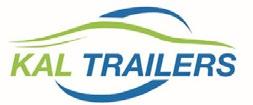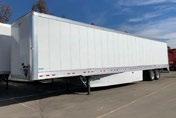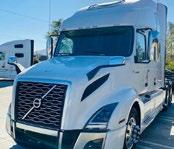


















Aswe are getting close to year end for 2022, we all know since the start of this year trucking is slowing down. Cost of doing business is going up really fast this year and net profit is close to nothing. Side by side new technology is coming into the trucking industry via new trucks, software and new rules and regulations. If you are not up to date on everything then it’s becoming almost impossible to run your business. We urge our government to look into this issue closely and try to bring laws which help our trucking industry to survive. We also urge our trucking industry to follow the laws to make sure they comply with the system. We are also seeing some of the laws are moving forward like hair drug testing, speed limiters and broker
transparency, also we know that parking is a very big issue for the trucking industry. We also urge local city governments to remember these are the trucks which bring almost everything to their cities. In this coming year we want to get together and try to make a better life for our truck drivers. Electric trucks are coming but infrastructure is not there but industry is already moving forward to Hydrogen/Electric hybrid trucks. Change is imminent but we urge manufacturers and administration to understand that changing so fast is going to make bad products as we have seen how DEF trucks have so many issues till today.
At this time we at Punjabi Trucking Magazine team wish you best of 2022 and prosperous 2023.

EDITOR
Raman S. Dhillon press@punjabitruckingusa.com
ASSOCIATE-EDITOR
Sunny Vraitch
CONTENT MANAGER
Rhea Randhawa
OFFICE MANAGER Melissa Nolasco info@punjabitruckingusa.com
Raman S. Dhillon sales@punjabitruckingusa.com
Maxx Printing, LLC
Harshpal Brar
Harjinder Dhesi

Rhea Randhawa
Harkiran Sidhu
Harjit Kaur
Ruchika Kashyap
Pash Brar
Raman Singh
Ravi Dhillon
Michael Smith
Jessie Dhillon
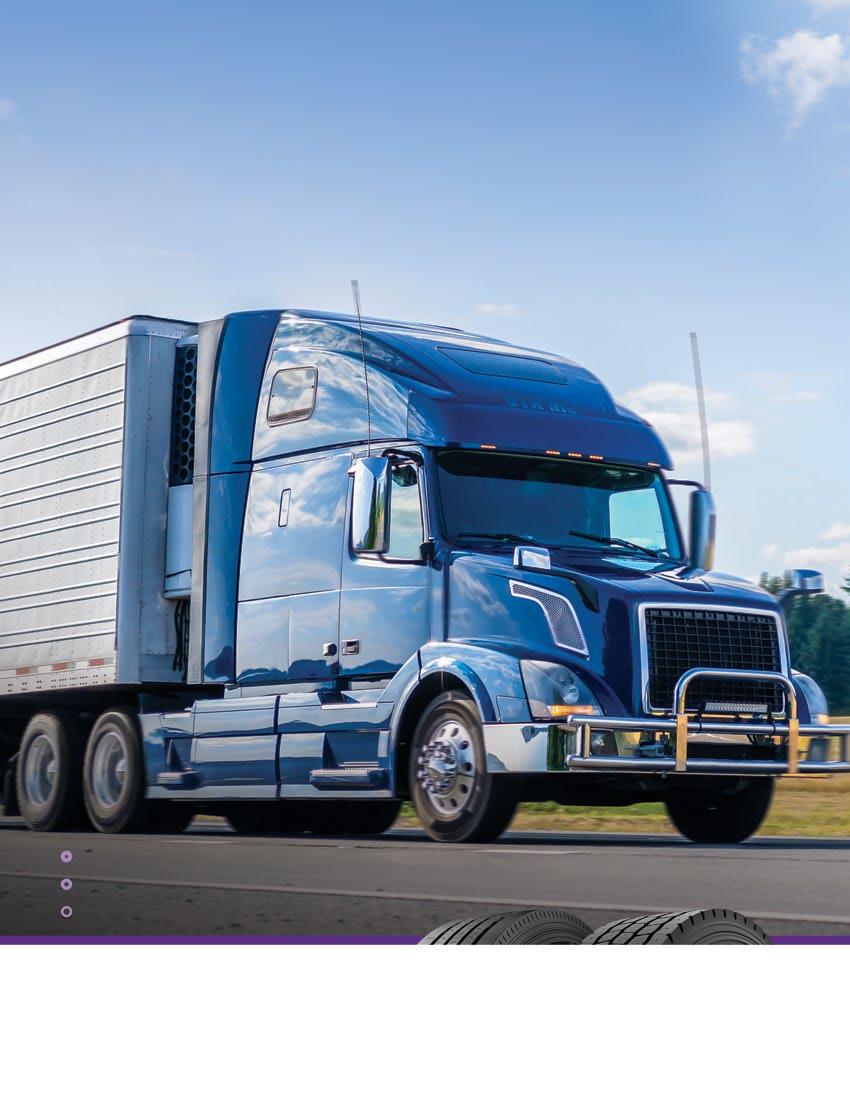



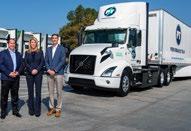






Anew proposal from the U.S. Department of Labor on the classification of workers is not what many trucking companies wanted yet is not as stringent as some state laws on classification, including California with its ABC test.

The 184-page document seeks to define the difference between an independent contractor and an employee. The document is a departure from current rules which were established under the Trump Administration. Under those regulations, it was much easier for a worker to be classified as an independent contractor.
The Biden Administration disagreed with those regulations and sought to toss them out as soon as they took office. A court order, however, restored the Trump rules, saying the administration had not followed the proper process. That process is now ongoing with the release of a Notice of Proposed Rulemaking on the federal register published in October.
In a news release, DOL said, “Misclassification is a serious issue that denies workers’ rights and protections under federal labor standards, promotes wage theft, allows certain employers to gain an unfair advantage over law-abiding businesses, and hurts the economy atlarge.”
According to the DOL news release, the rule would do the following:
Align the department’s approach with courts’ FLSA (Fair Labor Standards Act) interpretation and the economic reality test.
Restore the multifactor, totality-ofthe-circumstances analysis to determine whether a worker is an employee or an independent contractor under the FLSA.
Ensure that all factors are analyzed without assigning a predetermined weight to a particular factor or set of factors.
Revert to the longstanding interpretation of the economic reality factors. These factors include the investment, control and opportunity for profit or loss factors.
The integral factor, which considers whether the work is integral to the employer’s business, is also included.
Assist with the proper classification of employees and independent contractors under the FLSA.
Rescind the 2021 Independent Contractor Rule.
“While independent contractors have an important role in our economy, we have seen in many cases that employers misclassify their employees as independent contractors, particularly among our nation’s most vulnerable workers,” said Secretary of Labor Marty Walsh.
“Misclassification deprives workers of their federal labor protections, including their right to be paid their full, legally earned wages. The Department of Labor remains committed to addressing the issue of misclassification,” Walsh added.
“Misclassification deprives workers of their federal labor protections, including their right to be paid their full, legally earned wages. The Department of Labor remains committed to addressing the issue of misclassification,” Walsh added.
DOL had originally considered implementing California’s ABC test when classifying workers but rejected that idea because it “is inconsistent with Supreme Court precedent interpreting the FLSA.”
“However, the department believes it is legally constrained from adopting an ABC test because the Supreme Court has held that the economic reality test is the applicable standard for determining workers’ classification under the FLSA as an employee or independent contractor,” the proposed rule states.

According to DOL, the main factors considered by the high court include:
The extent to which the services rendered are an integral part of the principal's business.
The permanency of the relationship.
The amount of the alleged contractor's investment in facilities and equipment.
The nature and degree of control by the principal.
The alleged contractor's opportunities for profit and loss.
The amount of initiative, judgment, or foresight in open market competition with others required for the success of the claimed independent contractor.
The degree of independent business organization and operation.
Reaction to the proposal has been swift and mostly negative on the part of the trucking industry. Trucking companies will most likely incur higher costs because they will be hard pressed to show that their drivers are in fact independent contractors and not employees.
“American Trucking Associations is reviewing the new proposed rule and looks forward to providing feedback to the department,” Nick Geale, ATA Vice President of Workforce Policy, said in a statement. “But we are disappointed this proposal seeks to undo the current rule, which has brought needed clarity to the issue of independent contractor status.”
“We are just beginning to review this proposal, but any rule must
recognize the owner-operator model if it is to be successful when applied to trucking,” Todd Spencer, president of the Owner- Operator Independent Drivers Association, said in a statement.

“The administration’s stated desire to formulate a test that considers all aspects of a working relationship is promising, but we will carefully review every detail of their proposal and fight back against any provision that would unfairly stack the deck against true independent contractors.”
Analysts believe the new rule will be the topic of a slew of lawsuits going forward, prominent among them from ride-hailing services such as Uber and Lyft.
A recent study showed that the average Uber or Lyft driver makes about $7 an hour. Not surprisingly, shares of Uber and Lyft dropped 13% after the announcement of the proposal.
"There's going to be years of litigation over this," said Michael Lotito, a San Francisco-based attorney who represents employers and business groups. "This has the Supreme Court written all over it."
kwimAW dy vrgIkrx 'qy XUAYs ifpwrtmYNt Aw& lybr dw ie~k nvW pRsqwv auh nhIN hY jo bhuq swrIAW tr~ikMg kMpnIAW cwhuMdIAW hn, iPr vI vrgIkrx 'qy kuJ rwj dy kƒnW ijnHW s^q nhIN hY, ijs iv~c kYlIPornIAw vI ies dy ABC tYst nwl Swml hY[ 184 pMinAW dw dsqwvyz ie~k suqMqr Tykydwr Aqy ie~k krmcwrI ivckwr AMqr ƒ pirBwiSq krn dI koiSS krdw hY[ dsqwvyz mOjUdw inXmW qoN ie~k ivdwiegI hY jo trMp pRSwsn dy ADIn sQwipq kIqy gey sn[ auhnW inXmW dy qihq, ie~k krmcwrI leI ie~k suqMqr Tykydwr vjoN SRyxIb~D kIqw jwxw bhuq sOKw sI[
ibfyn pRSwsn aunHW inXmW nwl Asihmq sI Aqy Ahudw sMBwldy hI iehnW inXmW ƒ bwhr k~Fx dI koiSS kIqI[ ie~k Adwlq dy AwdyS ny, hwlWik, trMp inXmW ƒ bhwl krdy hoey ikhw ik pRSwsn ny shI pRikirAw dI pwlxw nhIN kIqI hY[ ieh pRikirAw hux AkqUbr iv~c pRkwiSq PYfrl rijstr 'qy pRsqwivq inXm bxwaux dy noits dy nwl jwrI hY[
ie~k inaUz rIlIz iv~c, DOL ny ikhw, "glq vrgIkrn ie~k gMBIr mu~dw hY jo PYfrl lybr stYNfrfW dy qihq krmcwrIAW dy AiDkwrW Aqy sur~iKAw ƒ nkwrdw hY, qnKwh dI corI ƒ auqSwihq krdw hY, kuJ mwlkW ƒ kwƒn dI pwlxw krn vwly kwrobwrW 'qy ie~k Anuicq Pwiedw pRwpq krn dI iejwzq idMdw hY, Aqy AwriQkqw ƒ v~fw nukswn phuMcwauNdw hY["
DOL inaUz rIlIz dy Anuswr, inXm hyT ilKy kMm krygw: AdwlqW dy FLSA (PyAr lybr stYNfrfz AYkt) dI ivAwiKAw Aqy AwriQk
AslIAq tYst nwl ivBwg dI phuMc ƒ iekswr krygw[
mltIPYktr ƒ bhwl krygw, sMpUrnqw-dyhwlwqW dw ivSlySx krygw ieh inrDwirq krn leI kI ie~k krmcwrI ie~k mulwzm hY jW FLSA dy ADIn ie~k suqMqr Tykydwr hY[
ieh XkInI bxwvygw ik iksy ivSyS kwrk jW kwrkW dy smUh ƒ pUrv-inrDwrq Bwr inrDwrq kIqy ibnHW swry kwrkW dw ivSlySx kIqw igAw hY[
ieh AwriQk hkIkq kwrkW dI lMby smyN qoN c~lI Aw rhI ivAwiKAw v~l muV jwvygw[ iehnW kwrkW iv~c invyS, inXMqrx Aqy lwB jW nukswn dy kwrk Swml hn[
Aiq zrUrI kwrn, jo ieh mMndw hY ik kMm ruzgwrdwqw dy kwrobwr dw Ain~KVvW AMg hY, vI Swml hY[
FLSA dy ADIn krmcwrIAW Aqy suqMqr TykydwrW dy shI vrgIkrn iv~c shwieqw krygw[
2021 dy suqMqr Tykydwr inXm ƒ r~d krygw[
lybr sk~qr mwrtI vwlS ny ikhw, "hwlWik suqMqr TykydwrW dI swfI AwriQkqw iv~c mh~qvpUrn BUimkw hY, AsIN bhuq swry mwmilAW iv~c dyiKAw hY ik ruzgwrdwqw Awpxy krmcwrIAW ƒ suqMqr TykydwrW vjoN glq SRyxIb~D krdy hn, Kws krky swfy dyS dy sB qoN kmzor kwimAW iv~c["
“glq vrgIkrn mzdUrW ƒ auhnW dIAW PYfrl ikrq sur~iKAw qoN vWJw krdw hY, ijs iv~c auhnW dI pUrI, kwƒnI qOr 'qy kmweI kIqI aujrq dw Bugqwn krn dw auhnW dw AiDkwr vI Swml hY[ lybr ivBwg glq vrgIkrn dy mu~dy ƒ h~l krn leI
vcnb~D hY, ”vwlS ny A~gy ikhw[
DOL ny Asl iv~c kYlIPornIAw dy ABC tYst ƒ lwgU krn bwry ivcwr kIqw sI jdoN vrkrW ƒ SRyxIb~D kIqw igAw sI pr ies ivcwr ƒ r~d kr id~qw ikauNik ieh "FLSA dI ivAwiKAw krn vwlI suprIm kort dI pUrv-Anumwn nwl AsMgq hY["
"hwlWik, ivBwg dw mMnxw hY ik ieh ABC tYst ƒ Apxwaux qoN kwƒnI qOr 'qy sImq hY ikauNik suprIm kort ny ikhw hY ik krmcwrI jW suqMqr Tykydwr vjoN FLSA dy ADIn krmcwrIAW dy vrgIkrn ƒ inrDwrq krn leI AwriQk AslIAq tYst lwgU hox vwlw imAwr hY," pRsqwivq inXm kihMdw hY[
DOL dy Anuswr, hweI kort duAwrw ivcwry gey mu~K kwrkW iv~c Swml hn: ijs h~d q~k syvwvW pRdwn kIqIAW jWdIAW hn auh ipRMsIpl dy kwrobwr dw ie~k Ain~KVvW AMg hn[ irSqy dI sQweIqw[ suivDwvW Aqy aupkrnW iv~c kiQq Tykydwr dy invyS dI rkm[ ipRMsIpl duAwrw inXMqrx dI pRikrqI Aqy ifgrI[ kiQq Tykydwr dy nPy-nukswn dy mOky[ dwAvw kIqy suqMqr Tykydwr dI sPlqw leIloVINdydUijAWdynwlKu~lybwzwrmukwbly iv~c pihlkdmI, inrxy, jW dUrdriSqw dI mwqrw[ suqMqr vpwrk sMgTn Aqy sMcwln dI ifgrI[
tr~ikMg audXog dy ih~sy 'qy pRsqwv 'qy pRqIikirAw qyz Aqy izAwdwqr nkwrwqmk rhI hY[ tr~ikMg kMpnIAW ƒ sMBwvq qOr 'qy

izAwdw Krcw Awvygw ikauNik aunHW ƒ ieh idKwaux leI s^q dbwA pwieAw jwvygw ik aunHW dy frweIvr Asl iv~c suqMqr Tykydwr hn nw ik krmcwrI[ "AmrIkn tr~ikMg AYsosIeySnW nvyN pRsqwivq inXm dI smIiKAw kr rhIAW hn Aqy ivBwg ƒ PIfbYk pRdwn krn dI aumId kr rhIAW hn," ink gyly, vrkPors pwilsI dy ATA vweIs pRYzIfYNt, ny ie~k ibAwn iv~c ikhw[ "pr AsIN inrwS hW ik ieh pRsqwv mOjUdw inXm ƒ r~d krn dI koiSS krdw hY, ijs ny suqMqr Tykydwr siQqI dy mu~dy 'qy loVINdI sp~Stqw ilAWdI hY[" "AsIN ies pRsqwv dI smIiKAw krnw SurU kr rhy hW, pr iksy vI inXm ƒ mwlk-Awprytr mwfl dI pCwx krnI cwhIdI hY jykr ies ƒ tr~ikMg 'qy lwgU hox 'qy sPl hoxw hY," tOf spYNsr, mwlk- Awprytr suqMqr frweIvr AYsosIeySn dy pRDwn, ny ie~k ibAwn iv~c ikhw[ "pRSwsn dI ie~k tYst iqAwr krn dI ie~Cw hY jo ie~k kwrjSIl irSqy dy swry pihlUAW 'qy ivcwr krdI hY, pr AsIN aunHW dy pRsqwv dy hr vyrvy dI iDAwn nwl smIiKAw krWgy Aqy iksy vI Aijhy pRbMD dy ivru~D vwps lVWgy jo shI suqMqr TykydwrW dy ivru~D fY~k ƒ glq FMg nwl stYk krygw[" ivSlySkW dw mMnxw hY ik nvW inXm A~gy jw ky keI muk~dimAW dw ivSw hovygw, ijnHW iv~coN Uber jW Lyft vrgIAW rweIf-hyilMg syvwvW pRmu~K hn[ ie~k qwzw AiDAYn ny idKwieAw hY ik AOsq Uber jW Lyft frweIvr lgBg $7 pRqI GMtw kmwauNdw hY[ hYrwnI dI g~l nhIN, pRsqwv dI GoSxw qoN bwAd aubr Aqy ilPt dy SyAr 13% if~g gey[ mwlk Aqy kwrobwrI smUhW dI numwieMdgI krn vwly sYn PrWissko-ADwrq AtwrnI mweIkl lotIto ny ikhw, "ies 'qy keI swl muk~dmybwzI hox vwlI hY[ ies au~qy suprIm kort iliKAw hoieAw hY Aqy ies dI suprIm kort q~k jwx dI pUrI sMBwvnw hY["


We’re already helping thousands of businesses grow with transparent & flexible factoring.
AsIN quhwfIAW ienvOiesW sym fyA
krdy hW Aqy quhwfI klYkSn vI hYNfl krdy hW[
AijhI iksI vI qrWH dI srivs leI mYnUM A`j hI kwl kro[

President –
(855) 879-1511 ext 332 (559) 900-9001 BDhillon@revinc.com 2941 Larkin Avenue Clovis, CA, 93612
After more than two years, the Federal Motor Carrier Safety Administration (FMCSA) plans to announce a decision early next year on a petition that would bring more transparency to broker related freight transactions. The original petition brought by the Owner-Operator Independent Drivers Association (OOIDA) and the Small Business in Trucking Coalition (SBTC) was published by the FMCSA in August 2020 seeking comment.
In a recent letter from the OOIDA, the group’s President and CEO Todd Spencer wrote, “We believe an update is warranted on where the agency stands on our outstanding petition and related comments from motor carriers.” In response, the FMCSA said the agency “has been considering the issues raised by OOIDA’s petition for rulemaking and based on that work is targeting early 2023 to issue a decision.”
FMCSA continued, “When assessing possible broker transparency rulemaking, FMCSA’s role is to remain within the bounds of our statutory authorities and
also takes into account whether and how additional rulemaking will effectively and efficiently resolve the issues identified.”

In the petition, the OOIDA asked that brokers be required to make available an electronic record of each transaction automatically within 48 hours of the contract being fulfilled. The petition also wanted brokers to be prohibited from including contract language requiring that carriers waive their ability to access transaction records. These records would include the amount the broker received for the service, the amount of any freight charge collected by the broker and the date it was paid to the carrier.
“OOIDA’s recommendations to enhance compliance are not attempts to control rates or impose burdensome requirements but would simply ensure that motor carriers have access to documents they have the right to view,” Spencer wrote.
In opposition to the OOIDA’s petition, the Transportation Intermediaries Association (TIA), a group that represents brokers, asked the FMCSA to repeal a provision in its rules regarding brokers that allows
carriers the right to review broker transaction records. The TIA filed its counter petition in November 2020, three months after the OOIDA filing.
TIA claims the provision contradicts the original intent of the Interstate Commerce Commission when it deregulated trucking in 1980 to ensure that “all unnecessary restrictions which might impede the free operation of the marketplace” are removed. FMCSA has not yet ruled on the TIA petition. The matter was a significant issue during the beginning of the pandemic with allegations from the OOIDA and SBTC claiming broker collusion on freight pricing. Then-President Donald Trump even repeated those allegations. Things calmed down as the economy surged in 2021 but could be an issue as an impending recession looms.
“As conditions in the trucking industry change, and more carriers face challenges, we can assure you that FMCSA and others in the federal government will continue to hear about the lack of broker transparency from small-business truckers,” Spencer wrote in his letter to FMCSA.
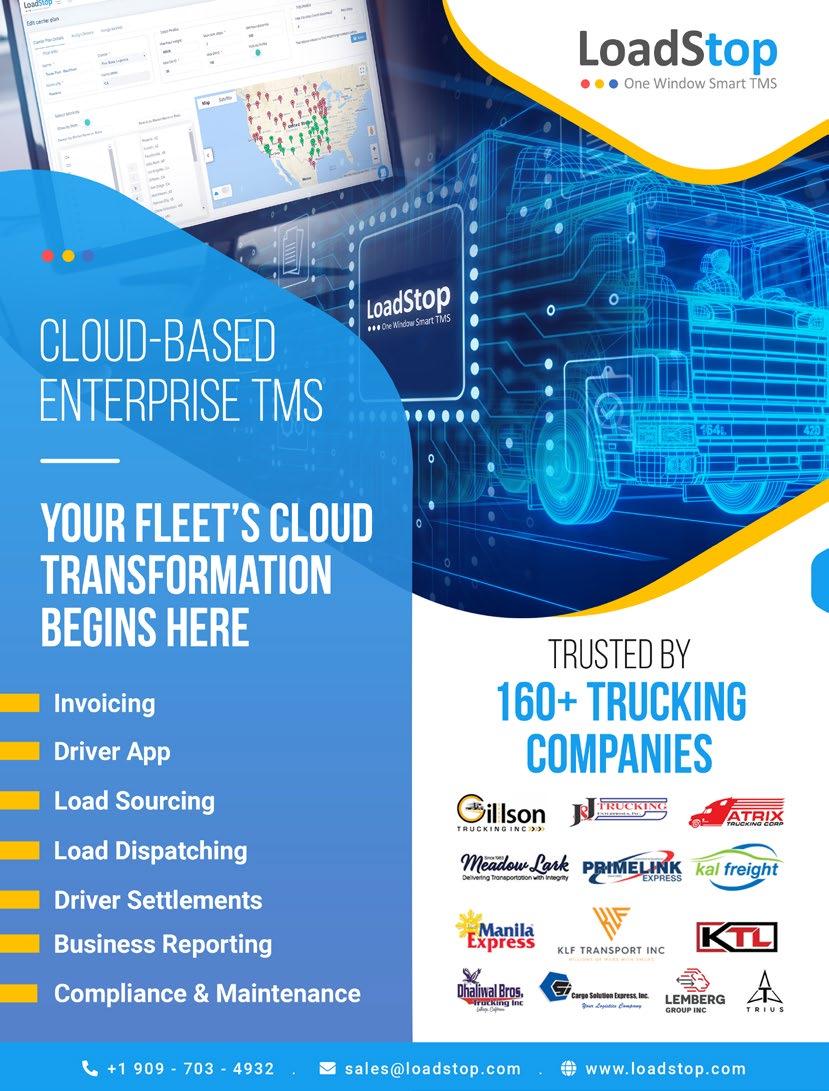
For the first time in nearly three years the Federal Motor Carrier Safety Administration (FMCSA) has a Senate-confirmed administrator. Ever since Ray Martinez resigned the position in 2019, the agency has been led by a series of acting administrators.
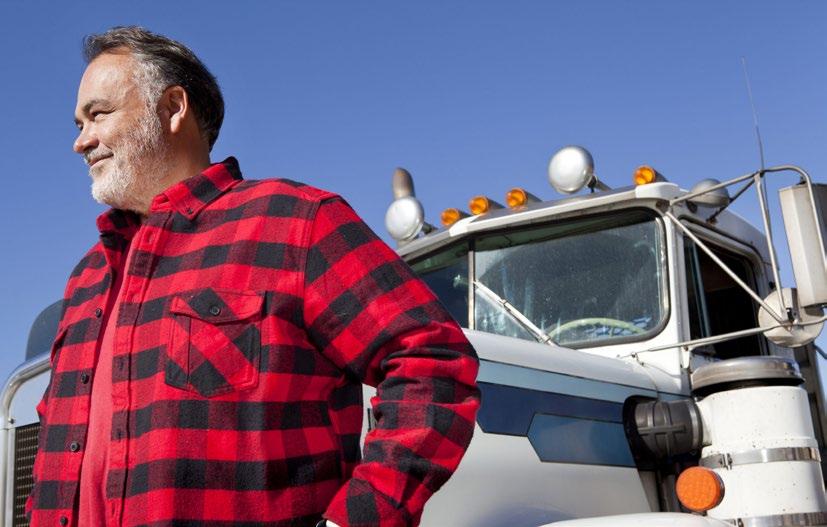
Robin Hutcheson, who replaced previous acting administrator Meera Joshi in January, was unanimously confirmed as the seventh administrator of the federal agency which was created in 2000 as the chief regulator of the trucking industry.
“During a time when our supply chains are being tested to their limits, I believe that her public and private experience, as well as her experience at both the local and federal level, will bring a unique perspective to the role and improve the safety of our transportation networks,” said Sen. Amy Klobuchar (D-Minn.), during the confirmation hearings.
Under Hutcheson, the agency faces several pressing issues, including supply chain problems, driver shortages, a perpetual increase in fatalities from trucking related crashes dating back to 2009, and several proposed new rules, including the possibility of speed limiters on commercial trucks.
One of Hutcheson’s top priorities is to implement the National Roadway Safety Strategy (NRSS) which was unveiled earlier this year. The new initiative was ushered in by Department of Transportation (DOT) Sec. Pete Buttigieg who has made it his goal to make U.S. roads safer.
The NRSS seeks to “address risky driving behaviors through research, education, technical assistance, and engagement with the behavioral and public health communities,” according to the NRSS Dashboard which was released in September. 800 drivers were killed in crashes involving commercial trucks in 2021.
As part of the Bipartisan Infrastructure Bill, funding for a comprehensive crash study will be funded. Hutcheson indicated the study would take about two years.
Another major issue on Hutcheson’s
plate is driver retention and recruitment. Last year, the American Trucking Associations estimated the nation needed an additional 80,000 truck drivers. To that end the DOT has looked at ways to “reduce barriers to drivers getting CDLs (commercial driver’s licenses).”
The agency has also issued a 90-day challenge to “accelerate the expansion of Registered Apprenticeships.” In addition, they have stepped up recruitment of underrepresented demographics such as veterans, women, and individuals under 21.
Hutcheson has also noted her agency will concentrate on increasing its use of technology, especially for inspections. Once a cumbersome process, the FMCSA hopes to streamline future big truck inspections, not only as an aspect of safety, but also to get drivers back on the road in a timely manner.
An issue that has been in the news lately is the number of requests for exemption from HOS rules. Hutcheson indicated that her agency was required by law to post such requests on the federal register for comment. She also indicated that there are no plans to change HOS rules in the near future.




In a signal that the federal government will help reinforce new worker classification laws recently passed in some states, the Federal Trade Commission (FTC) said in a statement: “Protecting workers from unfair, deceptive and anticompetitive practices is a priority, and the FTC will use its full authority to do so.”
Along with the National Labor Relations Board (NLRB), the
FTC has now inserted itself in the ongoing debate about what makes an employee, entitled to benefits such as health insurance and pensions, and what makes a “gig” worker, who is only due what is in an agreement decided on in advance between the worker and the business that is contracting with them.
In a joint statement released in the summer, the two agencies said they both “recognize that continued and enhanced coordination and cooperation concerning issues of common regulatory interest will help to protect workers against unfair methods of competition, unfair or deceptive acts or practices, and unfair labor practices.”
Analysts view the new messaging as proof that the Biden Administration will more aggressively enforce antitrust laws that have often been ignored in the recent past and rather than only relying on the Department of Labor (DOL), the feds are enlisting reinforcements.
In a review of the FTC statement, nationwide law firm Fisher Phillips said in an online opinion that “key situations” would likely interest the FTC such as “misrepresentation about the nature of gig work,” where an independent contractor is really under the control of the company that hired them.
Another possible situation of interest would be because of “diminished bargaining power,” when the amount of work available and the details of the work are not clear. Another would be “concentrated markets,” which could mean rideshare and food delivery would be examples of where there is “reduced choice for workers, customers and businesses.”
The NLRB position regarding independent contractors is currently in flux as states such as California have made their own definitions. One case making its way through the courts, known as Atlanta Opera, involving hair and makeup artists, will have significance in determining the difference between a contractor or gig worker and full employee in the eyes of the agency.
Analysts believe that eventually the Biden Administration will codify California’s ABC test in a rule proposed for the Wage and Hours division of DOL next year even though opposition will be fierce from business and contractors.

eyjMsI dIAW nzrW iv~c Tykydwr jW igg vrkr Aqy pUry krmcwrI ivckwr AMqr ƒ inrDwrq krn iv~c mh~qv r~Kdw hY[ ivSlySkW dw mMnxw hY ik AwKrkwr ibfyn pRSwsn kYlIPornIAw dy ABC tYst ƒ Agly swl DOL dy Wage and Hours ifvIzn leI pRsqwivq ie~k inXm iv~c kofIPweI krygw BwvyN ik kwrobwr Aqy TykydwrW duAwrw ivroD bhuq izAwdw hovygw[

support over 1,000 businesses with invoice management, credit underwriting, and collection services. By offering

transparent access to the factoring process, we help our
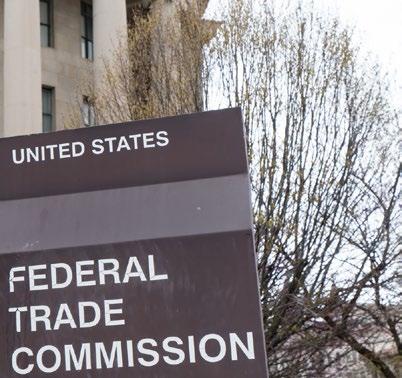

operations, maintain their competitive edge, and become leaders in
industries.
srkwr ny ieh sMkyq id~qw hY ik kuJ rwjW iv~c hwl hI iv~c pws kIqy nvyN vrkr vrgIkrx kwƒnW ƒ mzbUq krn iv~c mdd krygI[ PYfrl tryf kimSn (AYPtIsI) ny ie~k ibAwn iv~c ikhw: “krmcwrIAW ƒ Axauicq, DoKybwz Aqy pRqIXogI AiBAwsW qoN bcwauxw ie~k qrjIh hY, Aqy AY~P.tI.sI. Aijhw krn leI Awpxy pUry AiDkwr dI vrqoN krygI[” nYSnl lybr irlySnz borf (AYn.AYl.Awr.bI.) dy nwl, AYPtIsI ny hux Awpxy Awp ƒ ies bwry c~l rhI bihs iv~c Swml kIqw hY ik Aijhw ikhVw ibMdU ie~k krmcwrI ƒ Aqy ie~k igg vrkr jo ik isrP aunHW lwBW dw h~kdwr hY jo ik krmcwrI Aqy auhnW dy nwl iekrwrnwmw krn vwly kwrobwr dy ivckwr pihlW qoN qYA kIqy gey smJOqy iv~c hY ƒ ishq bImw Aqy pYnSnW vrgy lwBW dw h~kdwr bxwauNdw hY[
grmIAW iv~c jwrI kIqy ie~k sWJy ibAwn iv~c, dovW eyjMsIAW ny ikhw ik auh dovyN "ieh mMndy hn ik sWJy rYgUlytrI ih~qW dy mu~idAW bwry inrMqr Aqy viDAw qwlmyl Aqy sihXog, krmcwrIAW ƒ mukwbly dy Anuicq qrIikAW, Anuicq jW DoKybwz kMmW jW AiBAwsW, Aqy Anuicq ikrq AiBAws qrIikAW qoN bcwaux iv~c mdd krygw[" ivSlySk nvyN mYsyijMg ƒ sbUq vjoN vyKdy hn ik ibfyn pRSwsn AivSvws kwƒnW ƒ lwgU krygw, ijnHW ƒ hwl hI dy AqIq iv~c Aksr nzrAMdwz kIqw igAw hY Aqy isrP lybr ivBwg (fIEAYl) 'qy Brosw krn dI bjwey, PY~f rInPorsmYNtW ƒ sUcIb~D kr rhy hn[ AYPtIsI dy ibAwn dI smIiKAw iv~c, dyS ivAwpI kwƒn Prm iPSr iPilps ny ie~k AOnlweIn rwey iv~c ikhw ik "mu~K siQqIAW" sMBwvq qOr 'qy AYPtIsI ƒ idlcspI lYxgIAW ijvyN ik "ig~g kMm dI pRikrqI bwry glq ibAwnbwzI", ij~Qy ie~k suqMqr Tykydwr Asl iv~c aus kMpnI dy inXMqrx iv~c hY ijs ny auhnW ƒ nOkrI 'qy r~iKAw hY[
idlcspI dI ie~k hor sMBwivq siQqI "sOdybwzI dI SkqI Gtx" dy kwrn hovygI, jdoN auplbD kMm dI mwqrw Aqy kMm dy vyrvy spSt nhIN hn[ iek hor siQqI "kyNdirq bwzwr" hovygw, ijsdw mqlb ho skdw hY ik rweIfSyAr Aqy Bojn ifilvrI ies dIAW audwhrxW hoxgIAW, ij~Qy "krmcwrIAW, gwhkW Aqy kwrobwrW leI G~t cox" hY[ suqMqr TykydwrW bwry NLRB siQqI vrqmwn iv~c pRvwh iv~c hY ikauNik kYlIPornIAw vrgy rwjW ny AwpxIAW pirBwSwvW bxweIAW hn[ AtlWtw Epyrw vjoN jwxy jWdy, vwlW Aqy mykAp klwkwrW ƒ Swml krn vwly AdwlqW rwhIN Awpxw rsqw bxwaux vwlw ie~k kys,
The California desert just got a lot busier with the announcement by BNSF Railway that it will build a 4,500-acre facility in Southern California.
The $1.5 billion plan, labeled the Barstow International Gateway, is meant to ease congestion at the ports of Los Angeles and Long Beach. The plan includes the railyard and intermodal facility with warehouses for transferring freight from international to domestic containers.
Fort Worth-based BNSF (Burlington Northern Santa Fe Railway) said containers will be unloaded at the ports and then sent by rail to the Barstow center where items will be processed and then put on BNSF lines heading east. BNSF controls a 32,500-mile network in 28 states and three Canadian provinces.

“By allowing for more efficient transfer of cargo directly between ships and rail, the Barstow International
Gateway will maximize rail and distribution efficiency regionally and across the U.S. supply chain and reduce truck traffic and freeway congestion in the Los Angeles Basin and the Inland Empire,” said BNSF President and CEO Katie Farmer in a press release.
BNSF has indicated that no public funding will be used for the project which still has not released any timetables for construction. The project will create about 20,000 jobs, according to BNSF.
The two Southern California ports handle the highest container volume in the nation, according to the U.S. Department of Transportation. Last year, containerships were several miles out to sea at the ports awaiting unloading, heavily contributing to U.S. supply chain problems.
“The significance of BNSF’s investment to improve the supply chain here in California cannot be overstated,” said Trelynd Bradley, deputy director
of sustainable freight and supply chain development for California’s business and economic development office.
Port of Los Angeles Executive Director Gene Seroka said the project will reduce truck traffic on freeways and accelerate the movement of goods to consumers and businesses. BNSF has operated rail yards in Barstow for 140 years and is about 130 miles from the two ports.
This is the second major project announced recently to move port traffic by rail to inland warehouses for further processing. Developers representing previously released plans for a Mojave Inland Port, a 410-acre site at the Mojave Air and Space Port.
Located 90 miles from the ports, the new project would receive an estimated 3 million cargo shipping containers a year arriving on Union Pacific Railroad tracks and on trucks using the SR-14 Antelope Valley Freeway.


Although electric vehicles (EVs) are widely considered to have zero-emissions because they do not release greenhouse gasses (GHGs) or other pollutants into the atmosphere, some amount of pollution is often required for charging in most states.
While some charging stations are powered by solar or other renewable energy sources, many EVs are charged by power coming from electricity from the grid that comes from fossil fuel sources. Air pollutants from fossil fuels contribute to air quality and smog in cities. Fewer air pollutants are important for healthy communities since air pollution can lead to asthma, lung cancer and even death.
Varying by state, the amount of pollution is directly reflected by the burning of fossil fuels. States such as Iowa, Colorado, Kansas, California, South Dakota, and Wyoming have larger percentages of their electricity provided by renewables. In fact, Iowa produces 55% of its energy from wind.

In contrast, states such as Alabama,
Arkansas, Connecticut, and West Virginia produce virtually zero renewable energy. In the case of Connecticut, 39% of its power comes from nuclear power. West Virginia gets 90% of its energy from coal.
Not surprisingly, the environmental benefits of putting more EVs on the road in states like West Virginia is less than if that state got more of its energy from renewables. Most states have a broader mix of energy sources, such as renewables, natural gas, coal, petroleum and nuclear.
According to the Environmental Protection Agency, “Even accounting for these electricity emissions, research shows that an EV is typically responsible for lower levels of GHGs than an average new gasoline car. To the extent that more renewable energy sources like wind and solar are used to generate electricity, the total GHGs associated with EVs could be even lower.”
Not only do some EVs use fossil fuels for charging, but the manufacturing process tends to expend more emissions than regular gas-powered cars. The EPA, however, notes that GHG emissions from EVs will be far lower over the life of the car than standard combustion engine vehicles.
“The GHG emissions associated with an EV over its lifetime are typically lower than those from an average gasoline-powered vehicle, even when accounting for manufacturing,” said the EPA.
Another way to reduce any emissions from EVs is to recycle batteries. Currently very few EV batteries are recycled, but a report from the Department of Energy said that recycling could drastically reduce energy costs by 82%.
“Recycling of lithium-ion cells not only mitigates materials scarcity and enhances environmental sustainability, but also supports a more secure and resilient domestic materials supply chain that is circular in nature,” the report said.
The U.S. Department of Justice continues to win guilty pleas from individuals involved in staged accidents involving commercial trucks in the New Orleans area. Three more participants have now been convicted in the FBI’s “Operation Sideswipe” investigations.
The total number of those convicted has now risen to 41.
Defendants Herbert Allen, 37, and Dion Ridley, 23, admitted their guilt in a 2017 staged collision with a tractor-trailer operated by Gramercy, Louisiana-based Frisard’s Trucking Co. The men face up to five years in prison and fines of $250,000.
Allen falsely said he was driving the vehicle in the collision with the Frisard's truck, although law enforcement records show he was only a passenger. The actual driver of the car intentionally collided with the truck. Both men underwent medical treatment as part of the scam.
“Both defendants hoped that, through their false statements, they would secure lucrative monetary settlements from the owner, driver and insurer of the tractor-trailer,” Duane Evans, United States Attorney for the Eastern District of Louisiana, said in a statement.
Another defendant, Larry Picou, 56, of Gibson, Louisiana has accepted a plea deal for his role as a passenger in a Ford Expedition that was part of a staged collision with a tractor-trailer operated by Conley, Georgia-based B.A.H. Express. Like Allen and Ridley, he expected a large settlement for being part of the fraud. He also faces the potential of five years in prison.

The FBI believes there were more than 100 staged accidents with big trucks in the New Orleans area snice 2017. Several attorneys were involved in the scams, although only one has so far been charged with filing a fraudulent claim. Four others have been mentioned as conducting criminal activity in charging documents.
These staged accidents involved multiple people in a claimant vehicle which was part of a sideswipe accident with a commercial truck or trailer. The accidents usually involved little damage to either vehicle, yet claimants would assert major injuries that trucking company insurers would subsequently have to pay for.
Trucking companies that travel through the New Orleans area have since been alerted to the staged accidents.

Founder and former executive chairman of electric truck manufacturing start-up Nikola Corporation Trevor Milton has been found guilty of one count of securities fraud and two counts of wire fraud. Milton was accused of misleading investors about the technical progress his company was making in producing battery-electric trucks.
Famously, he was accused of lying, by promoting a video of the Nikola One semi-truck moving on its own power. As proven by activist short-seller Hindenburg Research, the truck was simply rolling down a hill.
Milton, 40, could face a prison term of 25 years. He resigned from Nikola in 2021.
In a tweet, U.S. Attorney Damian Williams said, "Trevor Milton lied to Nikola’s investors, over and over and over again. That’s fraud, plain and simple, and this Office has no patience for it. Never has, never will. Let this case serve as a warning. Anyone who plays fast and loose with the truth to get investors to part with their money. It won’t end well.”

The company Milton founded in his Salt Lake City basement in 2014 continues to be plagued by problems. In Sept., 93 of the company’s Nikola Tre trucks were recalled because seat belts were improperly installed. In addition, a partnership with General Motors to manufacture the Nikola Badger pickup truck has ended, with GM claiming Nikola supplied only an original design.

Well before Milton was convicted, Nikola agreed to pay $125 million in fines to the U.S. Securities and Exchange Commission as penalty for lying to investors. The company released a statement that Milton’s indictment and subsequent conviction had nothing to do with the current company.
“The company has cooperated with the government throughout the course of its inquiry. We remain committed to our previously announced milestones and timelines and are focused on delivering Nikola Tre batteryelectric trucks later this year from the company’s manufacturing facilities,” the statement said.
Milton’s defense argued that he loved the company he had built and often spoke as if things he hoped the company would achieve had already taken place. Milton is currently free on a $100 million bond until his sentencing in January.
Although they missed revenue forecasts for the third quarter of the fiscal year, not all was lost as electric vehicle manufacturer Tesla indicated it will produce 50,000 more units of its Semi all-electric Class 8 truck.

During its recent earnings call, the Austin-based company announced revenue of $21.45 billion, marking a $1.05 in adjusted earnings per share for investors. It missed its goal of 21.96 billion.
And, just as the company’s new Semi will begin rolling down California freeways for PepsiCo subsidiary Frito-Lay in Modesto, 50,000 new trucks are now slated to be built at the Tesla Gigafactory in Sparks, Nevada in 2024.
According to CEO Elon Musk, “It takes about a year to ramp up production. We’re tentatively aiming for 50,000 units in 2024 for the Semi in North America.”
In recent months, the automaker has produced more vehicles, up over 365,000 in Q3 from just 258,000 in Q2. Tesla also announced it will begin production of its Cybertruck in Texas after increasing production of its Model Y electric car.
On the call, Musk said Tesla’s could soon be more valuable than Apple. He said, "I see a potential path for Tesla to be worth more than Apple and Saudi Aramco combined. I see a way for
Tesla to be roughly twice the value of Saudi Aramco. This is the first time I've seen that potential." (Those two companies are worth more than $2 trillion each).
When asked about a potential recession, Musk responded, "We're very pedal to the metal, come rain or shine. We are not reducing our production in any meaningful way, recession or no recession."

With the commercial trucking industry moving to all-electric, hybrid and hydrogen fuel cell technology, Navistar introduced its recent S13 Integrated powertrain as its last internal combustion engine built from the ground up. Experts say it may be their best and definitely an improvement in lowering emissions.
One major improvement in the new engine is that it eliminates the need for a gas recirculation valve (EGR), which will reduce fuel consumption as well as maintenance bills. Recently, engine manufacturers have used jacket cooled EGR to cut dependence on selective catalytic reduction (SCR) and the diesel exhaust fluid (DEF) that enables it to kill nitric oxide and nitrous dioxide (NOx).
These engines walked a tightrope between a slight increase in engine stress and the overall complexity of the EGR system, while minimizing the need for DEF. With the S13, Navistar has built an engine that original diesel manufacturers would be proud of because EGR was a control system used only on passenger cars.
Although the new engine is not electric, it is a step forward in eliminating emissions. By 2030, Navistar projects that 50% of its new vehicle sales will be zero-emission models, expanding to 100% by 2040. Meaning that the S13
will more than likely become the premier Navistar engine for nearly two decades.
“Here we are today, launching an internal combustion engine,” said Navistar CEO Mathias Carlbaum at the introduction of the S13 in August. “There is no conflict in that. On the contrary, internal combustion engines will be required for many years until the electric vehicle can be fully adopted and when we have available cross-country infrastructure in place.”
One secret to the S13’s extraordinary ability to kill NOx involves two explanations: First, SCR (like the diesel particulate filter or DPF), as normally configured, only effectively works when the engine is pulling a load. Because big trucks often need to drive at low speeds in traffic, they can be slow toward after a cold start. Getting SCR to work faster at full efficiency is part of the new system’s advantages.
Navtej Singh, Navistar’s chief engineer for powertrain systems, said, “In order to retain heat and minimize the back pressure, the dual stage aftertreatment system was developed. This system has dual SCR to control the NOx emissions and a DPF to control the particulate matter [PM] emissions passively.”
Singh explained that exhaust flow recirculates within the aftertreatment system and helps to maintain heat,
especially for low-load cycles. This ultimately reduces the need to generate SCR warmup mode, which also assists in fuel efficiency.
“The exhaust gas recirculation along with other combustion strategies is used to warm up the exhaust aftertreatment faster and keep it warm during challenging operating conditions, like startup, idling and low-load conditions,” Singh said.
Another way the engine reduces NOx is with two dosers and two SCR reactors which are further helped using uncooled exhaust to increase SCR temperatures.
“This aftertreatment system consists of an SCR to DPF to SCR configuration. The upstream diesel exhaust fluid doser, which is the first doser, is closer to the engine turbocharger and gets the advantage of the hot temperature.” Singh said.
“This helps in reducing the NOx over the first SCR catalyst especially in lowload cycles or startup conditions. The downstream DEF doser, which is the second doser, plays a key role in reducing remaining NOx over the second, main SCR catalyst.” He continued.
Other manufacturers are likely to replicate Navistar’s EGR-less configurations for 2024. Volvo and Mack, with their turbo-compounding systems, however, will not be among those builders.
To optimize warehouse systems and overcome costly logistics issues, ecommerce companies such as Walmart have turned to fulfillment technology which includes warehouse automation, drone deliveries and advanced robotics.
In fact, Walmart has recently acquired grocery automation company Alert Innovation, a leader in warehouse fulfillment technology, for an undisclosed price. Walmart has been working with Alert since 2016.
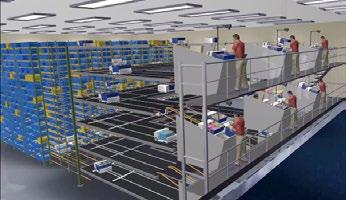
The use of fulfillment technology in preparing orders greatly increases efficiency. Order picking is one of the most complex tasks in the supply chain, which is why companies implement automated assistance technologies.

“Further investing in this technology will enable us to leverage our store footprint—4,700 stores located within 10 miles of 90% of the U.S. population—for storage and fulfillment,” said David Guggina, vice president of innovation and automation for Walmart.
Alert’s technology has been integral to Walmart warehouses in recent years, with the retailer piloting fulfillment technology in 2019 at a warehouse in Salem, New Hampshire. Alert’s Alphabot System uses autonomous carts to fetch groceries, including refrigerated items. The carts can move both horizontally and vertically.
The robotic carts share real-time order information as the system learns stocking optimization patterns. Because of this data-sharing capability, warehouse managers can forecast demand. For example, the system can predict that pasta and spaghetti sauce will generally be sold together so those items can be positioned close to each other.
“We will continue leveraging our development, manufacturing and deployment expertise to enable Walmart to build and scale MFC technology in its stores,” said Fritz Morgan, CEO of Alert. “With Walmart, we have the opportunity to positively impact millions of lives through the Alphabot System.”


Speed limiters on commercial trucks is one of the proposed new rules being looked at by the Federal Motor Carrier Safety Administration (FMCSA) for 2023. Earlier this year the agency indicated it would pursue the same path it started in 2016 when the speed limiter issue was last considered. In an April notice of intent, FMCSA said a supplemental notice of proposed rulemaking (SNPRM) “will propose that motor carriers operating commercial motor vehicles (CMVs) in interstate commerce with a gross vehicle weight…of 11,974
kilograms or more (26,001 pounds or more)…that are equipped with an electronic control unit (ECU) capable of governing the maximum speed be required to limit the CMV to a speed to be determined by the rulemaking and to maintain that ECU setting for the service life of the vehicle.”
The subsequent notice of proposed rulemaking published on the federal register drew over 14,500 comments. In 2016, the maximum speeds considered were 60, 65 and 68 miles per hour. FMCSA Administrator Robin Hutcheson said her agency would be diligent in examining the comments before it releases the SNPRM.

Another new rule would change broker and freight financial responsibilities. FMCSA said its notice of proposed rulemaking (NPRM), projected to be on the federal register by late January, “will propose changes to the broker/freight forwarder financial responsibility requirements as required by MAP-21.”
Automated driving systems (ADS) are also on the FMCSA docket with an upcoming NPRM about regulations governing commercial trucks equipped with ADS. New regulations would cover operation, inspection, and maintenance. Rules would “prioritize safety and security, promote innovation, foster a consistent regulatory approach to ADS-equipped CMVs, and recognize the difference between human operators and ADS.”
The FMCSA and the National Highway Safety Administration will also propose a requirement that automatic emergency braking (AEB) systems be included as standard equipment on big trucks. The proposal will include performance standards and maintenance requirements and test procedures for AEB systems.
Finally, FMCSA will publish an advanced notice of proposed rulemaking on the gathering of data regarding unfit motor carriers and get them off the roads.
“FMCSA would seek public comment about the use of available safety data, including inspection data, in determining carrier fitness to operate,” said FMCSA. “The agency would also seek public input on possible changes to the current threetier safety fitness rating structure. The action would also include a review of the list of Federal Motor Carrier Safety Regulations that the agency uses in its safety fitness rating methodology.”
Volvo Trucks North America’s largest West Coast dealership, TEC Equipment is working with Performance Team to integrate its growing batteryelectric fleet into its Southern California operations. In March 2022, Performance Team ordered 126 Volvo VNR Electrics to service its short haul warehouse distribution routes, demonstrating the company's ongoing commitment to reducing its carbon footprint. Performance Team’s full order of Class 8, zero-tailpipe emission trucks are scheduled to complete delivery by Q3 2023.
the widespread adoption of zero-tailpipe emission transportation solutions,” said Jared Ruiz, acting head of electromobility sales for North America, at Volvo Trucks North America. “TEC Equipment and Performance Team are taking a trailblazing role in demonstrating how a dealership and customer can collaborate to maximize the benefits of battery-electric trucks when they are deployed into fleet operations at scale.”
The scaled deployment of zero-tailpipe emission Volvo VNR Electric models is part of Performance Team’s environment, social and governance (ESG) strategy to decarbonize logistics. Its California-based fleet operates 215 trucks, which Performance Team intends to fully transition from diesel to battery-electric trucks. The 126 Volvo VNR Electric trucks are the first step in that plan, as well as creating new charging infrastructure to support its battery-electric fleet.
“Both Volvo Trucks and TEC Equipment continue to go above and beyond to support Performance Team’s growing battery-electric fleet. One example is the ongoing training they are providing to help our drivers optimize the range of the Volvo VNR Electric, including how to leverage regenerative braking benefits to add power back to the battery,” said Michael Gallagher, head of indirect sourcing, North America, at Performance Team. “Overall, our drivers have had a very positive experience with the Volvo VNR Electric.”
As of October 2022, Performance Team has taken delivery of its first 30 Volvo VNR Electric trucks, with 16 operating from its Santa Fe Springs location and an additional 14 trucks set to begin operating from its Commerce location later this month.
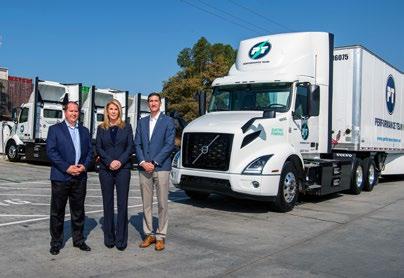
Performance Team worked closely with the sales team at TEC Equipment - Fontana, a Volvo Trucks’ Certified EV Dealership, and Volvo Trucks North America to identify the ideal Volvo VNR Electric configurations needed to run its daily freight routes. In addition, the partners leveraged Volvo Trucks’ Electric Performance Generator (EPG) tool, which simulated Performance Team’s real-world routes to determine which ones were best suited for the Volvo VNR Electric trucks, taking into consideration operational factors such as speed, payload, terrain, and ambient temperature. The EPG also considers specific route details, including traffic patterns, to determine if an opportunity charge would be required.
“Introducing any new technology into your fleet operations can come with a learning curve, which we are definitely seeing as customers make the switch from diesel to battery-electric trucks. It is inspiring to see our very first Volvo Trucks Certified EV Dealer working side-by-side with the largest Volvo VNR Electric fleet in the world, both of which are fully committed to facilitating
Performance Team is also taking advantage of the Volvo Gold Contract, Volvo Trucks’ premier service offering for the VNR Electric model, a turn-key solution for the first six years of ownership that provides customers with access to 24/7 support, including tow services, should any issues arise. As part of the Volvo Gold Contract, TEC Equipment provides comprehensive services to Performance Team’s fleet including scheduled and preventative maintenance, towing and vehicle repair including the vehicle’s energy storage unit and the complete electromobility system, to ensure peak vehicle uptime, performance, and productivity.
As a Certified Uptime Center, TEC Equipment has a goal of diagnosing customer trucks within two hours of being brought in for service to minimize downtime and get trucks back on the road quickly. The Uptime Services bundle from Volvo Trucks has been adapted for the Volvo VNR Electric to include a battery monitoring service that further supports customer uptime and peak operating conditions and provide operational peace of mind.
“TEC Equipment is dedicated to providing our customers with a seamless transition to battery-electric trucks. It’s exciting to help Performance Team move beyond just a few battery-electric trucks to a full fleet and figure out how to make that functional and cost-effective,” said Tracey Craik, regional sales director, TEC Equipment. “We have a customer-focused approach at all of our dealer locations and collaborate with customers on an ongoing basis to ensure they are prepared and supported along every step of their electromobility journey.”
Automated driving systems, mostly those made
electric automaker

linked to 11 motor crash fatalities over the last four months according to data from the National Highway Traffic Safety Administration (NHTSA). Ten of the deaths were related to Tesla vehicles while the eleventh involved a Ford pickup truck.
The NHTSA data, however, does not indicate whether the automated systems were at fault or whether the crashes were caused by driver error. Four of the fatal crashes involved motorcycles colliding with Tesla’s, an occurrence that has been increasing. Two of the crashes were in Florida, one in California and another in Utah.
The federal agency has recently been tracking such instances of fatalities involving cars equipped with automated systems. Tesla currently has more than 830,000 vehicles on the road with some level of driver assistance. The agency is
now requiring companies to report all crashes involving self-driving vehicles as well as autos with advanced driving systems that can assume part of the driving duties.


Tesla’s crash numbers may appear elevated because the company uses telematics to monitor its vehicles to obtain real-time crash reports. NHTSA has been investigating Tesla’s Autopilot system since 2021 because of accidents involving Tesla’s colliding with emergency vehicles parked along roadways with flashing lights.
One critic has consistently alerted federal regulators to the danger posed by Tesla’s systems. Dan O’Dowd, a software entrepreneur, even made Tesla the focus of his short-lived senatorial campaign earlier this year in California. O’Dowd ran television ads in the state chronicling how Tesla’s using Autopilot can sometimes take on a mind of their own and unexpectedly veer into the wrong lane or toward the curb.
What the NHTSA has found so far is that the automated technology was too often being used in areas where its capabilities were limited and that drivers weren’t taking proper steps to avoid crashes despite warnings from the vehicle. In recent statements about the issue, Tesla CEO Elon Musk said, “At the point of which you believe that adding autonomy reduces injury and death, I think you have a moral obligation to deploy it. Even though you’re going to get sued and blamed by a lot of people. Because the people whose lives you saved don’t know that their lives were saved. And the people who do occasionally die or get injured, they know, or their state does, that it was, whatever, there was a problem with Autopilot.”
He points out that the company has more than three million vehicles on the road. He said, “That’s a lot of miles driven every day. And it’s not going to be perfect. But what matters is that it is very clearly safer than not deploying it.”






New York is now allowing commercial driver’s license (CDL) tests to be conducted by trucking companies and other third parties that are qualified to do so. It is the latest effort by the state to get more truck drivers on the road as quickly as possible.

An estimate made by the American Trucking Associations late last year indicated the nation was short about 80,000 drivers. The federal government and the states have been experimenting with different solutions to the problem.
“We are doing more than just getting drivers licensed and, on the road, we are creating new avenues that will keep New York moving,” said Gov. Kathy Hochul about the initiative which was announced in September. “By allowing third parties to offer road tests for truck and bus drivers, we will help get children to school, get vital goods where they need to go, and much more. My administration is committed to continuing efforts that will address commercial driver shortages, helping drive the state’s economy forward.”
The state’s goal is to continue to increase the number of places where potential
drivers can be licensed, including partnerships with the State University of New York, the Thruway Authority, New York Racing Association, and the State Office of General Services to use their lots for road tests.
In addition, the state DMV has removed a 14-day waiting period between obtaining a permit and being able to test on the road. They have also increased capacity for written exams.
The state has changed its Vehicle and Traffic Laws to establish an intrastate CDL Class A young adult training program, which enables DMV to issue a Class A CDL to drivers between 18 and 20-years old. The state indicated this will expand employment opportunities for young drivers. Before this amendment, drivers under 21 could only obtain a Class B or C CDL because a Class A CDL is required to drive tractor-trailers.
Third parties that meet the state’s qualifications can apply for certification to administer tests by accessing the state’s DMV website. Organizations that qualify must sign a memorandum of understanding provided by the DMV.
Nongovernmental groups must also maintain a $20,000 bond.
These third parties need to create a detailed route for their CDL road test course that is state approved. Potential examiners must also receive DMV training which is monitored by DMV staff.
In response to this expedited process, the DMV has established a training and monitoring system to qualify CDL examiners to administer road tests in compliance with state and federal regulations. The DMV stipulates that any examiner from a driving school cannot test an individual trained by that school.
“By approving these third parties to conduct commercial road tests, we are giving trucking and transportation companies the tools to get their newest drivers licensed and qualified to work faster,” said DMV Commissioner Mark Schroeder.
“These drivers are crucial to almost every aspect of life in New York in every corner of the state, and we need more of them. DMV will be taking all measures possible to ensure the road tests administered by the third parties are done properly,” concluded Schroeder.


Pacific Coast leaders from California, Washington, Oregon, and British Columbia recently met to sign an agreement expanding their partnership to fight climate change. The group originally established the Pacific Coast Collaborative in 2013 to advance clean energy and a zero-emissions future.
“The West will continue to lead the way toward a carbon-free future that supports our economy, our people, and our planet.
We don’t have all the answers. And so, we seek to share best practices, we seek to compete,” said California Gov. Gavin Newsom during a press conference after the ceremonial signing of the agreement with Washington Gov. Jay Inslee, Oregon Gov. Kate Brown, and British Columbia Premier John Horgan.
The area involved has a population of 57 million people and boasts a combined gross domestic product of $3.5 trillion. The collaborative has focused on innovative low-carbon technologies in transportation and infrastructure for medium- and heavy-

duty trucks. “The West Coast is united as we lead the way toward a clean energy future that helps our entire region and economies to thrive,” said Brown. “In Oregon, we have set ambitious goals to reach 100% clean energy sources, reduce carbon emissions and comprehensively address climate change.” The three governments have agreed to collaborate on electric vehicle charging stations, the development of a clean energy electrical grid and zeroemission ports. In addition, the group will seek to protect its communities from climate-related wildfires, drought, heat waves and rising sea levels.
“Our partnerships speak to just how diverse and interconnected the green energy economy has already become. We know where it goes from here — onward to a cleaner, cheaper, and more efficient energy economy that averts climate calamity at the same time,” said Inslee.
One major project already underway is the West Coast Electric Highway which would place direct-current charging

stations every 25-50 miles along Interstate 5, U.S. Route 99, and other main arteries from California to British Columbia.
“Working together, we’re charting a path to a cleaner, stronger future with good jobs and opportunities for people on both sides of the border,” said Horgan. The group has also discussed with neighboring western states about “transitioning to a Western regional grid operator that would provide clean energy and other benefits to each state and the region, while respecting the energy policy preferences of each state and the needs and interests of non-participating utilities.”
California has also actively been working with international leaders on cleanenergy collaborations such as a recent memorandum of cooperation with Canada, Japan, and New Zealand. Another ongoing collaboration between California and the Netherlands will share best practices on ways to reduce emissions at ports from trucks, commercial ocean liners, harbor craft and port equipment.
Sharan Taj PaulArecession is often defined by two consecutive fiscal quarters of negative economic growth. The U.S. just recorded its second month in the red.
Despite a continuing robust job market, particularly for truck drivers, KeyBanc Capital Markets Inc. predicts weakness in the trucking and logistics market because of ongoing economic downturns in the U.S. and worldwide.
Not surprisingly, KeyBanc’s air freight and logistics analysts have noted that freight activity has been “seasonally weak.” Therefore, KeyBanc is expecting tepid third quarter numbers which will continue into 2023. Some have dubbed it a “trucking winter.”
In other words, trucking companies should tighten their belts, even as fuel prices continue to be unstable. In addition, spot rates have already declined by 30% compared to last year, according to KeyBanc analysts. Furthermore, they’re expecting trucking’s larger contract market to suffer mid-single-digit percentage declines in the coming months.
The dire predictions have led some experts to believe that many small trucking companies will be pushed out of the market because usually high end of year rates may not materialize as retailers have stockpiled goods in response to supply chain problems.
Therefore, spot rates have seen a significant hit so far this year and only the biggest companies may survive. This decline is driven both by overcapacity because too many truck drivers jumped into the red-hot 2021 market, and the continuing softness in demand which is the usual result of a recession.

In fact, spot rates have declined by nearly 33% from the beginning of this year to the beginning of October. This is at a time when fuel and other costs have soared.
mMdI ƒ Aksr nkwrwqmk AwriQk ivkws dIAW lgwqwr do iv~qI iqmwhIAW duAwrw pirBwiSq kIqw jWdw hY[ AmrIkw ivc ieh lgwqwr dUjw mhInw hY ijs ivc AwriQk ivkws nkwrwqmk siQqI iv~c drj kIqw igAw hY[ hwlWik tr~k frweIvrW dw nOkrI bwzwr kwPI mzbUq hY pr KeyBanc Caiptal Markets Inc. ny AmrIkw Aqy ivSv Br iv~c c~l rhI AwriQk mMdhwlI dy kwrn tr~ikMg Aqy lOijsitks mwrkIt iv~c kmzorI dI Biv~KbwxI kIqI hY[ hYrwnI dI g~l nhIN hY ik, KeyBanc dy hvweI BwVy Aqy lOijsitks ivSlySkW ny not kIqw hY ik BwVy dI gqIivDI "mOsmI qOr 'qy kmzor" rhI hY[ ies leI, KeyBanc qIjI iqmwhI ivc iq~Ky nMbrW dI aumId kr irhw hY jo 2023 q~k jwrI rhygw[ keIAW ny iesƒ “trucikng iwnter” ikhw hY[ ieh ikhw jw skdw hY ik BwvyN eINDn dIAW kImqW AsiQr hn pr tr~ikMg kMpnIAW ƒ pUrI iqAwrI k~sxI cwhIdI hY[ ies qoN ielwvw, KeyBanc ivSlySkW dy Anuswr, ipCly swl dy mukwbly spwt ryt pihlW hI 30% G~t gey hn[ ies qoN ielwvw, auh aumId kr rhy hn ik Awaux vwly mhIinAW iv~c tr~ikMg dy v~fy kMtrYkt mwrikt ƒ m~D-isMgl-AMk pRqISq dI igrwvt dw swhmxw krnw pvygw[ gMBIr Biv~KbwxIAW ny kuJ mwhrW ƒ ieh ivSvws krn leI pRyirq kIqw hY ik bhuq swrIAW CotIAW tr~ikMg kMpnIAW ƒ mwrkIt qoN bwhr D~k id~qw jwvygw ikauNik Awm qOr 'qy swl dy AMq iv~c au~cIAW drW pUrIAW nhIN ho skdIAW ikauNik pRcUn ivkryqwvW ny splweI cyn sm~isAwvW dy jvwb iv~c mwl dw BMfwr kIqw huMdw hY[ spwt rytW iv~c ies swl hux q~k ie~k mh~qvpUrn igrwvt vyKI geI hY Aqy ieh ikAws hY ik isrP sB qoN v~fIAW kMpnIAW hI bc skdIAW hn[ ieh igrwvt dw krn hY zrUrq qoN v~D lokW duAwrw 2021 dI mwrkIt dOrwn tr~k frweIvrI ivc Awauxw Aqy mMg iv~c inrMqr Gwt jo ik ie~k mMdI dw Awm nqIjw hY[ drAsl, ies swl dI SurUAwq qoN AkqUbr dI SurUAwq q~k spwt ryt lgBg 33% Gty hn[ ieh Aijhy smyN iv~c hY jdoN bwlx Aqy hor lwgqW iv~c vwDw hoieAw hY[

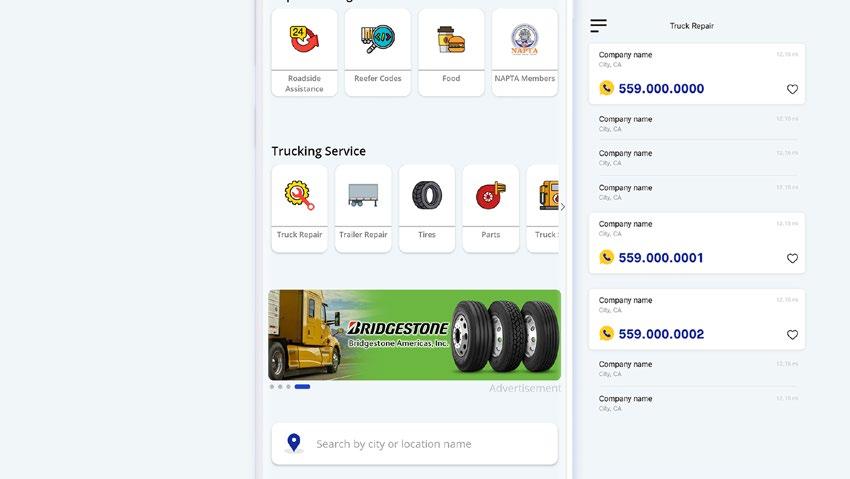





tYknwlojI tr~k frweIivMg dI dunIAw 'qy lgwqwr hwvI huMdI jw rhI hY ikauNik ie~k sMBwvI nvyN sMGI inXm Anuswr AMqrrwjI vpwr iv~c Swml iksy vI vpwrk motr vwhn leI ielYktRwink pCwx pRxwlI hoxI zrUrI hY jo ik au~c-joKm vwly ieiqhws vwly tr~kW jW kYrIArW ƒ inSwnw bxwaux iv~c ieMspYktrW dI mdd krygI[ sqMbr iv~c PYfrl motr kYrIAr syPtI AYfiminstRySn (FMCSA) duAwrw jwrI pRsqwivq inXm bxwaux dw AgwaUN noits, gupqqw Aqy sur~iKAw dy nwl-nwl eyjMsI ƒ keI nvIAW tknwlojI cuxOqIAW nwl ikvyN A~gy vDxw cwhIdw hY, vrgy keI svwlW 'qy ienput dI qlwS kr irhw hY[ noits iv~c ikhw igAw hY, “FMCSA ielYktRwink pCwx dy v~K-v~K pihlUAW dy sMbMD iv~c hor jwxkwrI mMg irhw hY, ijs iv~c sB qoN vDIAw sMBv qknIkI Aqy sMcwln sMklpW dy nwl-nwl sMbMiDq lwgqW, lwB, sur~iKAw, kmzorI, gupqqw Aqy hor sMbMiDq qYnwqI Aqy sMcwln pRBwv Swml hn[
hor svwlW iv~c Swml hY ik ielYktRwink pCwx dy ih~sy vjoN ikhVw fytw Swml kIqw jwxw cwhIdw hY, iesdI vrqoN ikvyN kIqI jwxI cwhIdI hY Aqy iesƒ ikvyN sur~iKAq kIqw jwvygw[ FMCSA AijhIAW zrUrqW ƒ sQwpq krn dI aumId kr irhw hY jo sur~iKAw AiDkwrIAW ƒ vwierlY~s tknwlojI duAwrw vwhn dy motr kYrIAr irkwrf dI pCwx krn dy Xog bxwauxgIAW[

nvyN inXm dw ivroD qyz ho igAw hY[ hux q~k 400 qoN v~D it~pxIAW krn vwilAW iv~coN izAwdwqr dw ivroD kIqw igAw hY[ ieh it~pxIkwr izAwdwqr CotIAW Aqy suqMqr tr~ikMg kMpnIAW hn[ keIAW ny
ErvylIAn SbdW iv~c nvyN inXm dw hvwlw id~qw, iesƒ "iBg Brother" ikhw[ hwlWik, ie~k pRmu~K tr~ikMg sMgTn ny pRsqwv 'qy Ajy q~k koeI siQqI nhIN r~KI hY[ AmrIkn tr~ikMg AYsosIeySnW dy fYn horvQ ny ikhw ik ATA "CMVs (vpwrk motr vwhnW) dy sVk iknwry lwgUkrn ƒ vDwaux dy qrIikAW dI jWc krn leI shwiek hY["
"ikauNik ieh ie~k ANPRM (pRsqwivq inXm bxwaux dw au~nq noits) hY, ieh au~c p~Dr 'qy hY, Aqy FMCSA sMcwln lwgqW, lwBW, sur~iKAw kmzorIAW, Aqy gopnIXqw bwry qknIkI svwl pu~C irhw hY," horvQ ny ikhw[ "XkInn, vwierlY~s sVk iknwry inrIKxW dI Dwrnw AijhI cIz hY ijsdw hweIvy sur~iKAw leI lwB ho skdw hY[ pr aulJx hmySW vyrivAW iv~c huMdI hY[ ”
nvyN pRsqwv ƒ kmrSIAl vhIkl syPtI AlwieMs duAwrw pRyirq kIqw igAw sI, jo dlIl idMdy hn ik ie~k ielYktRwink pCwx pRxwlI ieMspYktrW ƒ au~c-joKm vwly kYrIArW ƒ inSwnw bxwaux iv~c mdd krygI Aqy cMgI ryitMg vwly kYrIArW ƒ keI jWcW qoN bcx iv~c vI mdd krygI[
"AsIN ie~k sMgTn dy qOr 'qy auh tknwlojI inrDwrq nhIN kIqI hY, ijsdI vrqoN tIcy ƒ pRwpq krn leI kIqI jwxI cwhIdI hY[ AsIN ies ArQ ivc tknwlojI mwhr nhIN hW, ”sIvIAYsey dy ifptI kwrjkwrI inrdySk, AYfrIn iglfIAw ny ikhw[
CVSA dw mMnxw hY ik pCwx pRxwlIAW dI vrqoN bwry vDyry crcw dI loV hY[ iglfIAw ny ikhw, “hux swrw ibMdU ieh hY ik AwE g~lbwq SurU krIey, ikauNik ie~Qy bhuq swry svwl hn[ "jvwb hoxy cwhIdy hn["
Central Valley will finally get a glimpse
new Semi trucks
the
to PepsiCo’s FritoLay plant in Modesto and a beverage distributor in Sacramento.
originally introduced a Semi prototype back in 2017, but delays have caused the company to postpone the introduction of the trucks until this December when Frito-Lay will deploy 15 new trucks with a total of 100 set to eventually go online.


Tesla CEO Elon Musk said his company wouldn’t be able to produce any new models this year because of parts shortages.
he soon withdrew those predictions after passage of the federal Inflation Reduction Act, which provides a heavy-duty truck federal tax credit of $40,000.
Immediately following passage of that bill, Musk tweeted that Semis with a 500-mile range would ship before the end of the year. That model is priced at $180,000 per unit.
According to its website, FritoLay “launched a milestone project” in Modesto with a goal of being “an industry-leading showcase for environmentally sustainable manufacturing, warehousing and distribution.”
Tesla’s main competitors in the commercial heavy-duty electric truck market are Sweden’s Volvo AB and Phoenix-

which announced in early October that it
fully electric trucks to Amazon.com Inc. by the end of the year.
deliver
Technology continues to invade the world of truck driving as a potential new federal regulation would require any commercial motor vehicle involved in interstate commerce to have an electronic identification system to help inspectors target trucks or carriers with a history of being high-risk.
The advance notice of proposed rulemaking, issued by the Federal Motor Carrier Safety Administration (FMCSA) in September, is looking for input on several questions such as privacy and security as well as how the agency should proceed with several new technology challenges.
“FMCSA is soliciting further information regarding various aspects of electronic identification including the best possible technical and operational concepts along with associated costs, benefits, security, vulnerability, privacy and other relevant deployment and operational implications,” the notice said.
Other questions include what data should be included as part of the electronic identification, how it should be used and how it will be protected. FMCSA is hoping to establish requirements that would enable safety officials to identify a vehicle’s motor carrier record through wireless technology.
Opposition to the new regulation has been intense. A majority of the more than 400 commenters so far have been mostly opposed. These commenters have largely been small and independent trucking companies. Some referred to the new rule in Orwellian terms, labeling it as “Big Brother.”
One major trucking organization, however, has yet to take a position on the proposal. Dan Horvath of the American Trucking Associations said the ATA is “supportive of examining ways to increase roadside enforcement of CMVs (commercial motor vehicles).”
“Being that this is an ANPRM (advanced notice of proposed rulemaking), it’s at a high level, and FMCSA is asking technical questions about operational costs, benefits, security vulnerabilities, and privacy,” Horvath said. “Certainly, the concept of wireless roadside inspections is something that could have a benefit to highway safety. But the devil is always in the details.”
The new proposal was prompted by the Commercial Vehicle Safety Alliance, who argue that an electronic identification system would help inspectors target high-risk carriers and would also help carriers with good ratings avoid numerous inspections.


“We have not as an organization specified the technology that we believe should be used to achieve the goal. We’re not technology experts in that sense,” said Adrienne Gildea, CVSA’s deputy executive director.
CVSA believes that more discussion is needed about the use of identification systems. “The whole point now is let’s get the conversation started, because there are so many questions,” Gildea said. “There needs to be answers.”
Recently released, the federal government’s Significant Rulemaking Report includes several items from the Federal Motor Carrier Safety Administration (FMCSA). One of the most important of the items involves gathering input on ways to eliminate unfit and dangerous motor carriers.
The report said, “FMCSA is seeking information on how the Agency might use data and resources more effectively to identify unfit motor carriers and to remove them from the Nation's roadways.”

Specifically, it “seeks public comment about the use of available safety data, including inspection data, in determining carrier fitness to operate.” To that end, the agency will release an advance notice of proposed rulemaking on Jan. 30.
In addition, the agency wants input on its three-tier safety fitness rating structure. The process would include a review of regulations used by FMCSA to determine its fitness rating methodology.
Another item from the report makes drivers shipping agricultural goods, including livestock, within 150 air miles of the original location during harvest and planting seasons exempt from hours-of-service (HOS) rules. Drivers are also excused from 30-minute rest breaks when carrying livestock.
Probably the most controversial of the new items in the
report involves speed limiters. The agency continues to gather data and feedback on the issue, but the Owner-Operator Independent Drivers Association strongly opposes any use of limiters, citing research that indicates use of a limiter can increase safety issues.
Other items in the report include proposed rules on how to regulate automated driving systems, making automatic braking systems standard equipment on big trucks and future rulemakings regarding Mexico-domiciled motor carriers and consumer complaints.

Amajor debate has surfaced in the transportation industry as car haulers who move new and used cars across the country are lobbying the Biden Administration and Congress to increase truck weight limits on the nation’s roads because new cars, especially electric vehicles (EVs), have gotten significantly heavier, in some cases by as much as two-thousand pounds.
The car hauling industry hopes the Biden Administration will be sympathetic to their cause as the president has put forth a nationwide goal to move as quickly as possible to an all-electric transportation fleet. Biden’s goal is for EVs to make up half of all new cars sold in 2030.

Because of their heavy batteries, EVs are much heavier than gas-powered vehicles. The rail industry and road safety organizations, however, oppose the increase in weights. Opponents of the increase say that it will damage roads and bridges and that more heavy vehicles are harder to stop, leading to more crashes.
"With any incremental change comes incremental danger, and that results in more fatalities," said Cathy Chase, President of Advocates for Highway and Auto Safety.
Currently, the maximum weight is about 80,000 pounds. The American Trucking Associations have asked for a 10% increase, noting that current limits will badly hamper the distribution of automobiles.
The extra weight, about 8,000 pounds, could allow car haulers to carry the same number of EVs as traditional cars. In fact, Ford’s new F-150 Lightning all-electric pickup truck weighs 1,600 pounds more than a gas-powered model. Likewise, the all-electric Volvo XC40 Recharge SUV weighs about 1,000 pounds more than its gas-powered equivalent.
"The auto transporter industry needs a modest 5% to 10% weight variance. Otherwise, an alreadychallenged supply chain will require more tractor trailer rigs on the nation’s highways to deliver the same number of finished vehicles. That means more
miles driven, more wear and tear on our roads, more fuel used, and more emissions," said Rep. Rodney Davis (R-Indiana), a member of the House Transportation Committee and ranking member of the highway subcommittee.
An idea to solve the issue includes allowing the higher weights for up to 300 miles. Haulers usually unload at least one car by then, which would put them back to original limit.
California, which is moving faster than any other state to full EV sales, has already increased weight limits for trucks carrying goods in and out of its ports to ease supply-chain problems. Temporary permits starting in November of last year lifted weight restrictions for trucks to 88,000 pounds.
So far, the state has not done a study of the effect of the increased weights. “The department is not aware of any collisions or other safety impacts of trucks that are utilizing these permits,” William Arnold, a California transportation department spokesman, said.
During the recent National Coalition on Truck Parking virtual workshop, California State Transportation Agency (Caltrans) freight policy coordinator Eric Fredericks discussed the state’s ongoing plans to link truck parking with the state’s push for zeroemission vehicles.
“It’s not a dream that zero-emission trucks are going to happen someday in California. They are happening right now,” said Fredericks. “It’s a big challenge, and it’s especially important for our owner-operators, who sometimes park near where they live.”
A major target for new truck parking and charging infrastructure is around the state’s major container ports. Currently, the nearest truck parking is about 60 miles away from these ports.
This lack of parking is a “huge issue” for the state’s mandate “to achieve a zero-emission truck and bus California fleet by 2045 everywhere feasible, and significantly earlier for certain market segments such as last-mile delivery and drayage applications,” said Fredericks.
Caltrans is working with the state energy commission to examine the impact of zero-emission heavy trucks on the state’s electricity grid to determine EV charging needs for heavy trucks. They hope to construct a plan to merge EV infrastructure with truck parking.
Fredericks said that planners have learned that charging infrastructure “can’t fit into the normal footprint of parking spaces, so we need to build more truck parking spaces. That’s really critical to make sure we have charging infrastructure and we don’t reduce the number of available spaces to meet our client goals.”
State officials have also enlisted input from trucking companies, independent owner-operators, warehouse managers, electric truck manufacturers and the California Trucking Association. The state is actively looking for private sector partnerships for new truck parking locations.
Researchers are particularly concerned with the safety problems surrounding insufficient truck parking. Studies show that on average, a passenger vehicle is striking a truck parked along the highway at least once per day.
“This is the first time we know that, in California, we really measured the safety impacts of having trucks parked on the side of the highways,” Fredericks said. “We especially found a lack of truck parking near areas where there is a lot of freight in warehousing facilities.”

With sharp incentives from both the Inflation Reduction Act, passed earlier this year, and the Infrastructure and Jobs Act, passed last year, Columbus, Indianabased Cummins Inc. has announced it will manufacture hydrogen electrolyzers on an 89,000 square foot section of its existing plant in Fridley, Minnesota.
Electrolyzers use electricity to split water into hydrogen and oxygen. Hydrogen storage captures the power of clean energy for later use. Storage of electricity is one of the most difficult problems that green energy technology faces going forward.
Electrolyzer systems use renewable electricity from solar, wind or hydropower to produce carbon-free green hydrogen, which is storable as a compressed gas or liquid. Energy-dense green hydrogen is important to the future of moving away from fossil fuels for big trucks.
In June, Cummins named Alexey Ustinov the leader of its hydrogen generation business as Vice President of Electrolyzers. Ustinov has been with Cummins for 28 years, most recently leading the company’s off-highway diesel engine segment.
“Expanding Cummins’ electrolyzer manufacturing footprint to the United States is a milestone not only for our company but an important step in advancing global decarbonization efforts,” said Ustinov.
He continued, “This is a reflection of increasing government support through the Inflation Reduction Act, Hydrogen Hubs and a blossoming hydrogen economy in the states. Cummins’ ability to leverage our manufacturing, engineering, and sourcing knowledge to build capacity will help us meet increased customer demand and continue to accelerate the clean energy transition.”
Trucking analysts predict that Cummins’ move away from diesel engines to zero-emission electric and hydrogen powered truck engines could mean significant revenue growth of about $3 billion a year by the end of the decade.
At its Minnesota plant, Cummins will manufacture its HyLYZER-500 and HyLYZER-5000 proton exchange membrane (PEM) electrolyzers. They can provide power needs from 1.25MW to more than 200MW for small- and large-scale hydrogen generation projects.
The company already boasts the world’s largest PEM electrolyzer in operation at 20MW at a facility in Quebec, and it is working on a 25MW installation with NextEra Energy Resources in Florida. That plant is expected to begin operation in 2023.
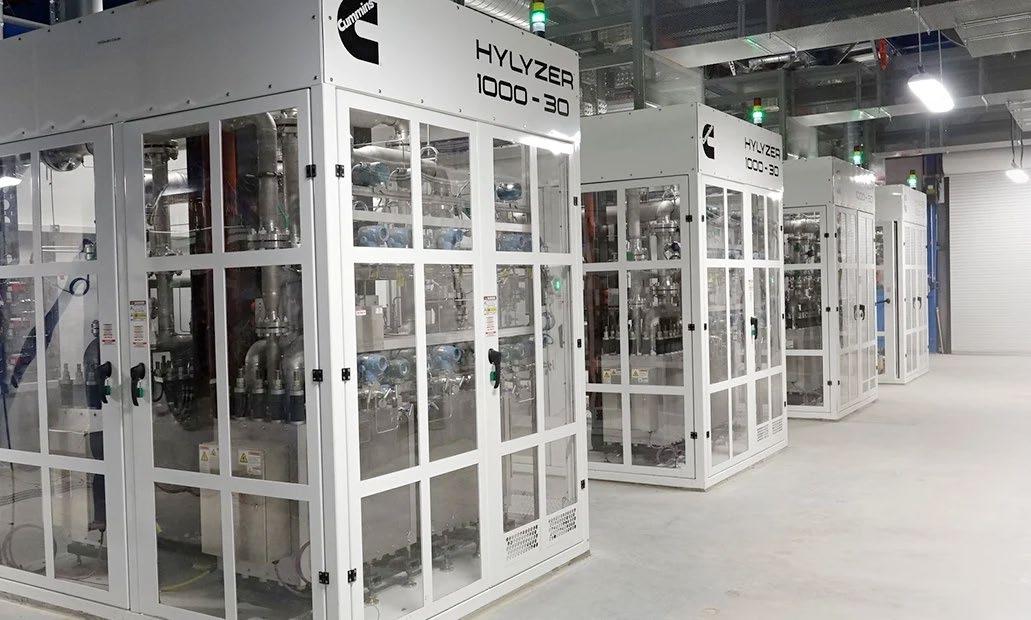
after the seventeenthcentury mathematical genius who coined the phrase, “I think, therefore I am,” Canadabased Descartes Systems Group recently announced a partnership with Minnesota-based logistics service provider C.H. Robinson, who will use Descartes’ Macropoint platform to expand carriers’ ability to connect with its network.
pleased to be able to help carriers in C.H. Robinson’s North American freight network delivers important information on their shipments,” said Descartes General


Manager Dan Cicerchi, “Supply chains today are extremely fast-paced and fluid, and the ability to access timely insights into the precise movement of goods is critical for logistics service providers and shippers alike.”
For carriers that use Descartes MacroPoint to provide status updates on the freight they’re hauling, C.H. Robinson has extended its agreement with Descartes so that carriers can continue to transmit updates through their preferred process. C.H. Robinson provides carriers with digital connectivity through its Navisphere platform with direct
integration with a carriers’ existing technology as well as API integration with third-party technology such as electronic logging devices (ELDs).

According to its website, Descartes Macropoint delivers “a higher standard of service for customers and carriers alike.” The cloud-based platform connects road, air, and ocean carriers through telematics and electronic logging devices, transportation management systems, a mobile driver application, APIs, and the Descartes Global Logistics Network, a multimodal messaging network.

XPO Logistics, one of the largest less-than-truckload (LTL) carriers in the U.S., has announced that its Board of Directors has voted to approve the company’s spinoff brokerage unit, RXO, which will instantly be the fourth largest digital freight brokerage in North America with a network of about 100,000 independent carriers and 1. 5 million trucks.
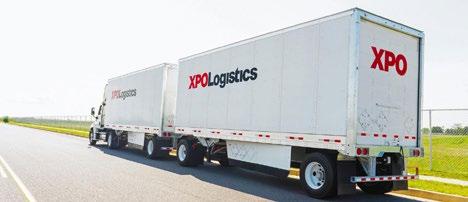
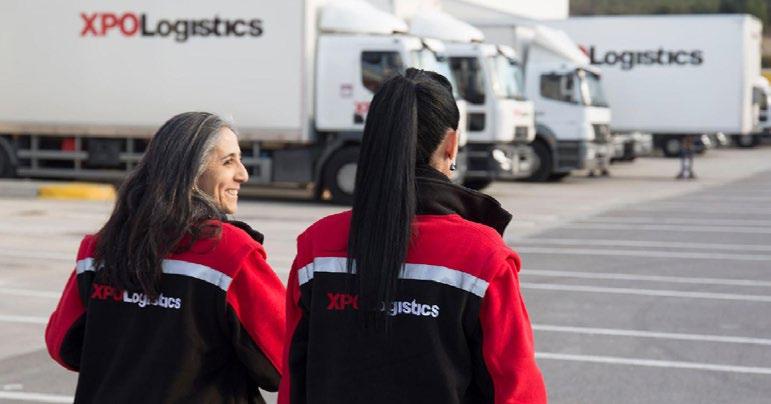
Brad Jacobs, previously XPO’s chairman and CEO, will now become the executive chairman of the XPO Board, while Mario Harik, the current XPO chief information officer and head of the LTL unit, will now become the company’s CEO.
Current XPO investors will now get one share of RXO for every share of XPO they currently control. This distribution should be concluded by Nov. 1.
“I’m extremely pleased that our spinoff has board approval and is moving toward a Nov. 1 distribution for our shareholders,” Jacobs said in a press release. “XPO and RXO will each benefit from a strong board of directors who bring valuable perspectives to the growth strategy. I look forward to continuing to collaborate with Mario and his team to create significantly more value in XPO with the board’s support.”
In other XPO related news, the company has plans to divest its European transportation unit. In addition, Carl Anderson is now the company’s chief financial officer (CFO), replacing Ravi
Tulsyan who is leaving the company after overseeing the transition.
“Carl is a strong B2B finance leader with an operational orientation and a long track record of delivering on goals,” said Jacobs. “His broad executive experience in the commercial vehicle sector is valuable context for his role at XPO, where we have one of the largest LTL fleets in North America.”
“Ravi has made many vital contributions to XPO’s success over the last six years. He was instrumental to our GXO spin-off in 2021, and more recently led our finance organization through the RXO spin-off process and the sale of intermodal,” concluded Jacobs. “We wish Ravi every success, and we’re pleased that he’ll be available to Carl after the separation to support a seamless transition.”





ibfyn pRSwsn leI smUh eyjMfy dIAW AweItmW dy ivckwr, $1 itRlIAn ibpwrtIsn ienPrwstRkcr ib~l ƒ lwgU krn qoN v~D koeI vI mh~qvpUrn nhIN hY jo sMGI hweIvy pRogrwmW leI $350 iblIAn qoN v~D dw pRqIinD krdw hY[ ies lwgU krn dw bhuqw ih~sw nvyN PYfrl motr kYrIAr syPtI AYfiminstRySn (FMCSA) pRSwsk rOibn hcsn dI god iv~c AwauNdw hY[ hcsn dy Anuswr, ausdI nOkrI iv~c keI

qrHW dy pRojYktW leI nIqI bxwauxw Aqy Koj Aqy PMifMg ƒ lwgU krnw Swml hY[ ijs iv~c sur~iKAw, splweI cyn iv~c knYktIivtI dy nwl-nwl tr~k pwrikMg Aqy nvyN frweIvrW dI sMBwl Aqy BrqI Swml hY[ ie~k Kws Poks vpwrk tr~kW dy phIey ip~Cy vDyry AOrqW ƒ ilAwauxw hY[ hcsn ny hwl hI iv~c GoSxw kIqI hY ik tr~ikMg slwhkwr borf dIAW nvIAW giTq AOrqW audXog iv~c AOrqW dIAW
BUimkwvW iv~c vwDy leI lwbI krn leI ies igrwvt ƒ pUrw krngIAW[ gru~p AOrqW leI krIAr dy mOikAW, isKlweI, slwh, is~iKAw Aqy phuMc ƒ auqSwihq krn dI koiSS kr irhw hY[ hcsn ny borf dy kMm leI lgwqwr Awpxy auqSwh dI Awvwz id~qI hY[ borf iv~c AmrIkn tr~ikMg AYsosIeySnz dy kwrjkwrI aup pRDwn AYlIzwbYQ brnw, tImstrz dI AMqrrwStrI bRdrhu~f ifptI fwierYktr AYNjolI fIgRws, boiel trWsportySn dI BrqI, irtynSn Aqy frweIvr ifvYlpmYNt dI mYnyjr, lOrw durIAw, tr~ikMg AYsosIeySn iv~c APrIkn AmrIkn vUmYn sih-mwlk inkol vwrf, Aqy srivs ieMplweIz ieMtrnYSnl XUnIAn qoN AYnI bwly Swml hn[ hcysn leI sB qoN mh~qvpUrn mu~idAW iv~coN ie~k tr~k pwrikMg hY[ sqMbr iv~c, trWsportySn ivBwg (DOT) ny tr~k pwrikMg ivsqwr pRogrwmW iv~c rwj eyjMsIAW dI mdd krn leI nvIN ivAwpk mwrgdrSn pyS kIqI[ rwStrI pwrikMg sMbMDI icMqwvW ƒ h~l krn leI FMCSA dw ieMpu~t mh~qvpUrn hY[ DOT dy sk~qr pIt butIgIg ny ikhw, "mYN dyS Br dy Axigxq tr~krW qoN suixAw hY ik ikvyN tr~k pwrikMg dI Gwt kwrn auhnW dw smW Aqy pYsw Krc huMdw hY Aqy ies dy nwl hI pwrikMg dI Gwt sVkW ƒ G~t sur~iKAq bxwauNdI hY Aqy swfI splweI cyn ƒ kmzor krdI hY[" hwlWik ienPrwstRkcr ib~l iv~c koeI PMifMg Swml nhIN kIqI geI sI, pr DOT ny ies mksd leI rwjW ƒ pYsw moV id~qw hY[ pYsw sur~iKAw dy AiDkwr Kyqr iv~c AwauNdw hY jo DOT leI ie~k qrjIh bixAw hoieAw hY[ “tr`k pwrikMg ie~k sur~iKAw mu~dw hY, tr`k frweIvrW Aqy hor swry sVk aupBogqwvW leI, iesy krky FHWA (PYfrl hweIvyA pRSwsn) ny ieh XkInI bxwaux leI swfy mwrgdrSn ƒ Apfyt kIqw hY ik ibpwrtIsn ienPrwstRkcr ib~l dy qihq AiDkwrq nvyN PwrmUly Aqy AKiqAwrI gRWt pRogrwmW iv~c tr~k pwrikMg pRojYktW leI Xogqw bwry koeI svwl nhIN hY[” FHWA dI kwrjkwrI pRSwsk stYPnI polYk ny ikhw[
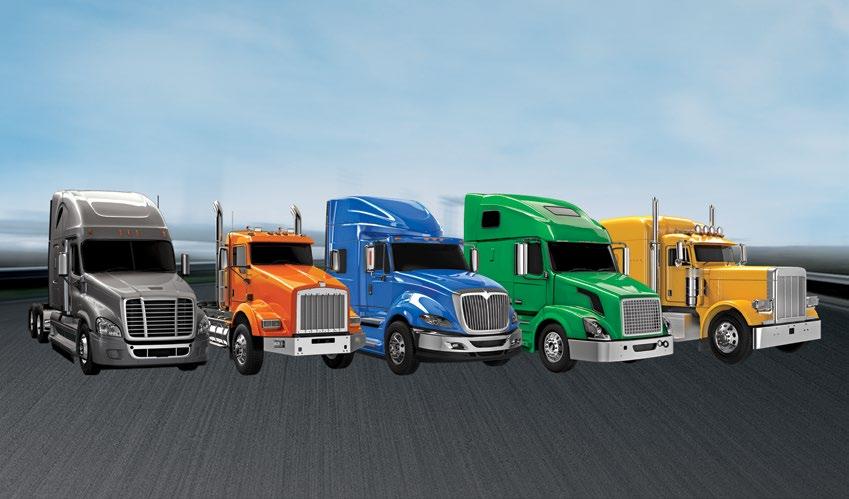
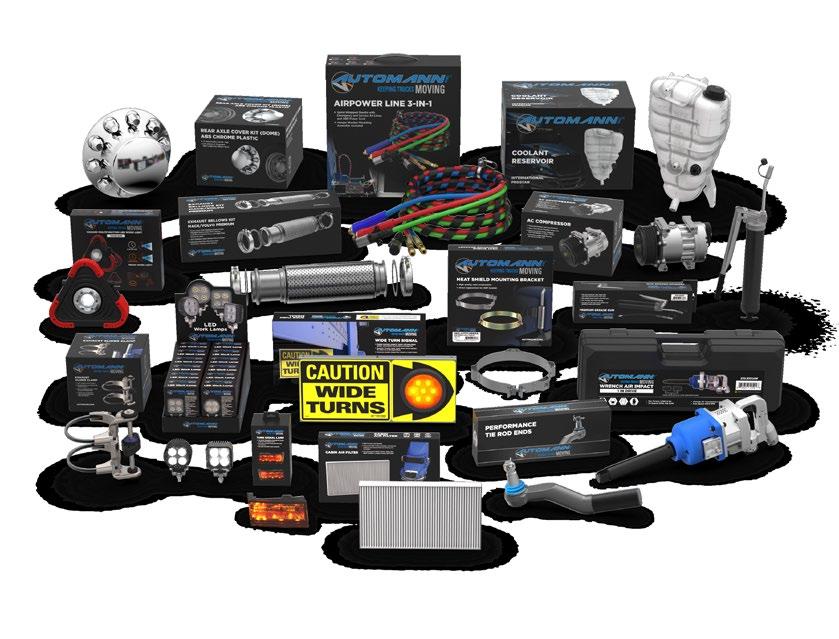
Amid all the agenda items for the Biden Administration, none is more important than the implementation of the $1 trillion Bipartisan Infrastructure bill that delegates more than $350 billion for federal highway programs. Much of that implementation falls in the lap of new Federal Motor Carrier Safety Administration (FMCSA) Administrator Robin Hutcheson.
According to Hutcheson, her job involves formulating policy and implementing research and funding for a variety of projects, including safety, connectivity in the supply chain as well as truck parking and the retention and recruitment of new drivers. One particular focus is to get more women behind the wheels of commercial trucks.
Hutcheson recently announced that the newly formed Women of Trucking Advisory Board will meet this fall to lobby for an increase in women’s roles
in the industry. The group is looking to promote career opportunities, training, mentoring, education, and outreach for women. Hutcheson has continually voiced her enthusiasm for the board’s work.
The board includes American Trucking Associations Executive Vice President Elisabeth Barna, International Brotherhood of Teamsters Deputy Director Enjoli DeGrasse, Boyle Transportation’s manager of recruiting, retention, and driver development, Laura Duryea, African American Women in Trucking Association Co-owner Nicole Ward, and Anne Balay with the Service Employees International Union.
One of the most important issues on Hutcheson’s plate is truck parking. In September, the Department of Transportation (DOT) introduced new comprehensive guidance to help state agencies with truck parking expansion programs. FMCSA’s input is vital to
addressing national parking concerns.
DOT Secretary Pete Buttigieg said, “I’ve heard from countless truckers across the country about how the shortage of truck parking costs them time and money, not to mention making our roads less safe and weakening our supply chains.”

Although no funding was included in the infrastructure bill, the DOT has diverted money to the states for that purpose. The money comes under the jurisdiction of safety which continues to be a priority for DOT.
“Truck parking is a safety issue, both for truck drivers and all other road users, which is why FHWA (Federal Highway Administration) has updated our guidance to ensure there is no question about eligibility for truck parking projects in new formula and discretionary grant programs authorized under the bipartisan infrastructure law,” said FHWA Acting Administrator Stephanie Pollack.


